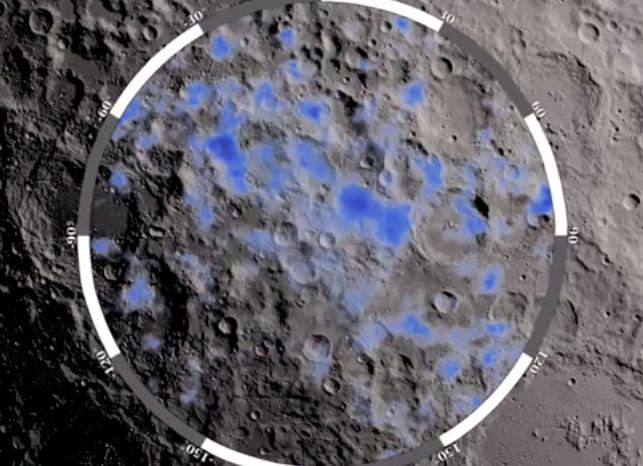

The blue areas show locations on the Moon's south pole where water ice is likely to exist (NASA/GSFC)
The Moon might seem like a poor place to hunt for water, but in fact there’s a decent amount of the stuff dispersed throughout the lunar soil — and even more of it existing as ice deposits in the dark recesses of polar craters. While the LCROSS mission crashed a rocket stage into one of these craters in October 2009 and confirmed evidence of water in the resulting plume of debris, there haven’t been any definitive maps made of water deposits across a large area on the Moon — until now.
Over the course of several years, NASA’s Lunar Reconnaissance Orbiter scanned the Moon’s south pole using its Lunar Exploration Neutron Detector (LEND) to measure how much hydrogen is trapped within the lunar soil. Areas exhibiting suppressed neutron activity — shown above in blue — indicate where hydrogen atoms are concentrated most, strongly suggesting the presence of water molecules… aka H2O.
The incredibly-sensitive LEND instrument measures the flux of neutrons from the Moon, which are produced by the continuous cosmic ray bombardment of the lunar surface. Even a fraction of hydrogen as small as 100 ppm can make a measurable change in neutron distribution from the surface of worlds with negligible atmospheres, and the hydrogen content can be related to the presence of water.
No other neutron instrument with LEND’s imaging capability has ever been flown in space.
Watch the video below for more details as to how LRO and LEND obtained these results:
“While previous lunar missions have observed indications of hydrogen at the Moon’s south pole, the LEND measurements for the first time pinpoint where hydrogen, and thus water, is likely to exist.”
What’s so important about finding water on the Moon? Well besides helping answer the question of where water on Earth and within the inner Solar System originated, it could also be used by future lunar exploration missions to produce fuel for rockets, drinking water, and breathable air. Read more here.
Video credit: NASA Goddard Space Flight Center
When massive stars reach the end of their life cycle, they undergo gravitational collapse and…
Planets are born in swirling disks of gas and dust around young stars. Astronomers are…
Sometimes, things across the vast Universe line up just right for us. The Einstein Ring…
Our Sun is a giant plasma windbag spewing a constant stream of charged particles called…
Humanity will eventually need somewhere to live on the Moon. While aesthetics might not be…
How can a geologic map of a lunar impact crater created billions of years ago…